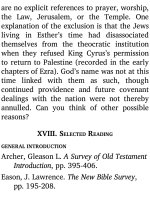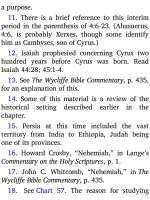Jensens survey of the old testament adam 559
Bạn đang xem bản rút gọn của tài liệu. Xem và tải ngay bản đầy đủ của tài liệu tại đây (126.92 KB, 4 trang )
disobedience
Word of God — written (Bible) and living
(Christ)
Faith — for salvation, and for Christian
living
Testing and discipline — their purposes and
rewards
Christian growth — the marks of spiritual
maturity
Old Testament institutions and New
Testament counterparts
Purposes of the Levitical ritual law
5. What new key words and phrases are
you observing?
6. Look for groupings of segments
according to similar subject, and try making
a simple, general outline of the epistle.
7. What is the main theme of Hebrews?
C. STRUCTURE OF THE EPISTLE
When various topical studies are outlined
on a survey chart, the structure of a book’s
composition becomes evident. The survey of
Hebrews, Chart 103, shows something of the
organization of the epistle. Study the chart
carefully, then note how the following are
shown on the chart.
1. There are thirteen chapters in Hebrews.
The chart shows thirteen segments (not all
beginning at the rst verse of a chapter)
plus an introduction (theme, 1:1-3) and
epilogue (13:22-25). Five warning sections
are parts of those segments. Which warning
section is a full segment? Which warning
sections conclude a segment? Which is in
the middle of a segment?
2. Basically, the epistle has two main
divisions: Instruction (1:1 — 10:18) and
Exhortation (10:19—13:25).
3. Study the key outline.
KEY OUTLINE OF HEBREWS
a. What Have We? (1:1—7:28). The
suggestion for this question really comes
from 8:1a, “Now the main point in what has
been said is this: We have….” In other
words, in chapters 1-7 the author is adding
up that which the believer has, in answer to
a question “What have we?” One can
visualize the Hebrew Christians saying,
“Why shouldn’t we go back to Judaism —
what do we have for being Christians?” The
author of Hebrews responds, “You ask,
‘What have we?’ Let me show you what we
have!”
b. We Have Such a High Priest (8:1—
10:18). The phrase “We have such a high
priest” comes from 8:1. Read the verse
again. The author is saying that we have in
Jesus a High Priest. But the emphasis is on
the word such. (In the original Greek the
word appears
rst, for emphasis.) The
author has shown this superiority in the
previous section, chapters 1-7. Observe the
outline on Chart 103 that shows Jesus as
divine Priest, redeemer Priest, apostle Priest,
perfect Priest, eternal Priest. All this adds up
to the sum “We have such a high priest.”
Although 8:1 refers back to the
cumulative inventories of chapters 1-7, it
also introduces this middle section, 8:1—
10:18. In this section the author continues
to show the superior priestly ministry of
Jesus (e.g., 8:6; 9:11), and he also shows in
detail the workings of that ministry.
c. Having, Therefore … Let Us (10:19—
13:25). Read 10:19-21 for the source of this









